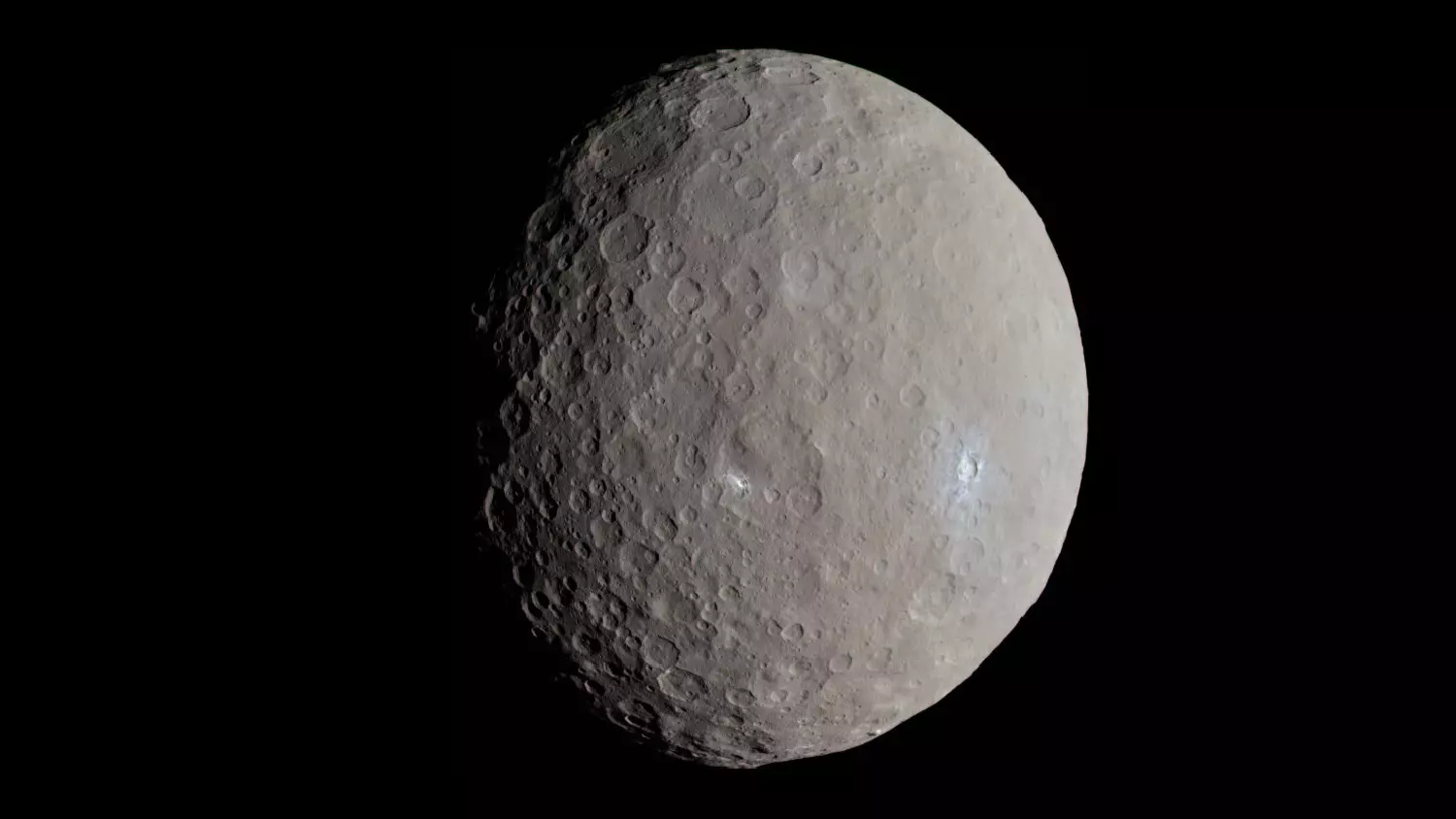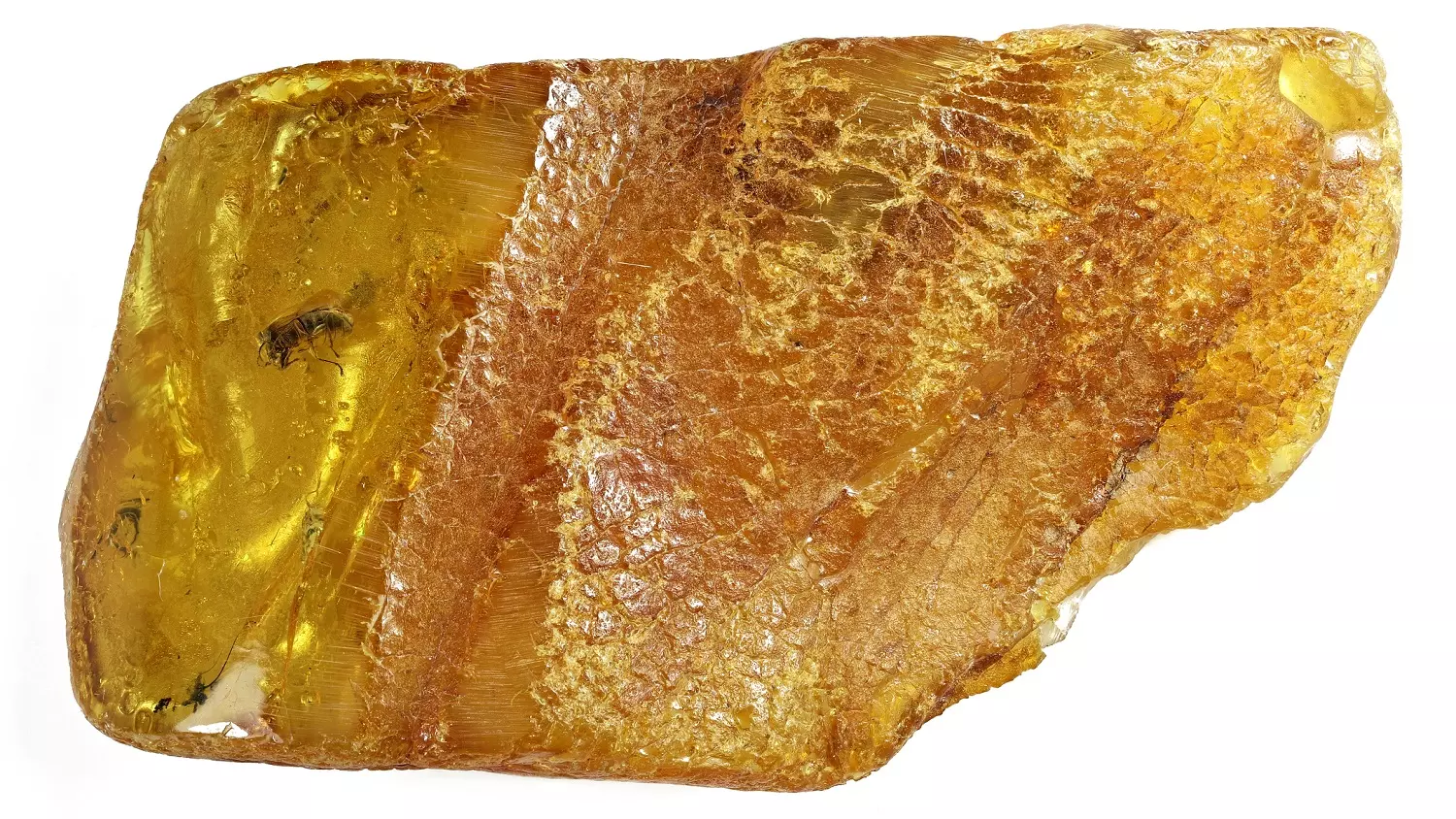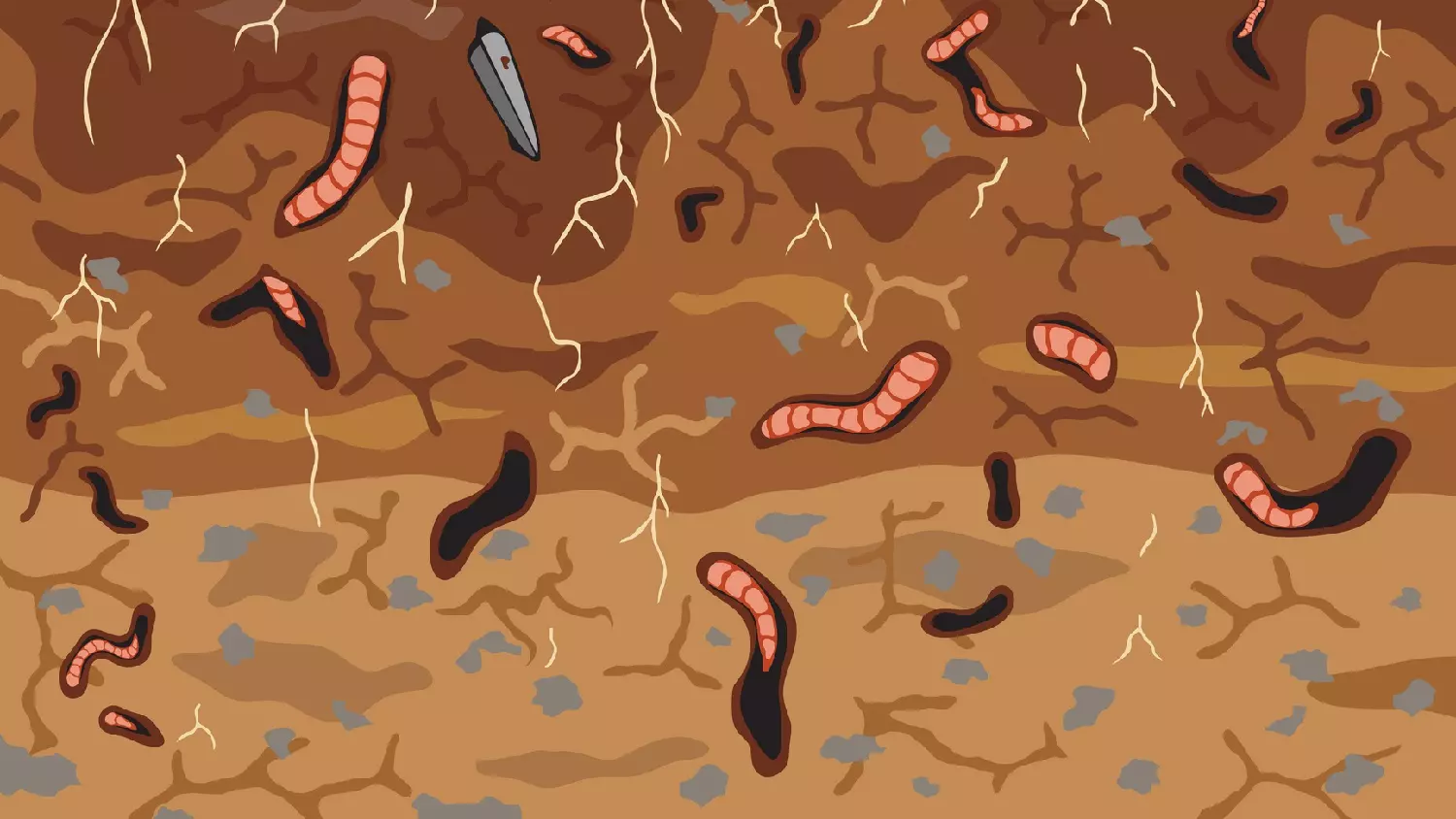[Originally published as the first section of Worlds of Creation: Asteroids]
On January 1, 1801, the Italian astronomer Giuseppe Piazzi discovered a new ‘planet’ in between the orbits of Mars and Jupiter. What a great way to bring in the new year!
Named Ceres, this new world was far smaller than the other seven planets (Neptune had not yet been discovered). Even the most powerful telescopes of the time could not discern any sizeable disk; the object resembled a star.
Piazzi initially thought that Ceres might be a comet. The central nucleus of a comet indeed looks point-like in a telescope. But Ceres was not surrounded by a coma—a cloud that typically surrounds the nucleus of a comet. Nor did it have a tail. Further observations revealed a fairly circular orbit, typical of a planet but unlike any comet.
The Discovery of the First Minor Planets
If you have never heard of the planet Ceres, that’s because it is no longer classified as a planet. It was “Plutoed” long before you were born. But even at the time of its discovery, Ceres was obviously far smaller than the other seven planets.
Even in the early 1800s the question was raised, “Should it really be classified as a planet?”
On March 28, 1802, Heinrich Olbers discovered another new ‘planet’: Pallas. Like Ceres, Pallas circles the sun in between the orbits of Mars and Jupiter. In fact, their orbital periods are nearly a match. Ceres takes 4.61 years to orbit the sun, and Pallas takes 4.62 years. And, just like Ceres, Pallas shows no discernable size even in the largest telescopes of the period.
William Herschel suggested that these new worlds were significantly different from the much larger planets, and therefore deserved their own new category. He suggested the term “asteroid” from the Greek meaning “star-like.” However, this term did not catch on immediately. Most astronomers continued to classify these new worlds as planets.
In 1804, Karl Harding discovered a third new ‘planet,’ which was given the name Juno. It too was “star-like” and circled the sun in between the orbits of Mars and Jupiter. The next new ‘planet’ would again be discovered by Olbers on March 29, 1807 and was given the name Vesta.
Eight years of additional searching revealed no new planets, which suggested to some astronomers that perhaps there were no more. From 1807 to 1845, the solar system had eleven planets: Mercury, Venus, Earth, Mars, Vesta, Juno, Ceres, Pallas, Jupiter, Saturn, and Uranus.
Today we refer to these four “extra” worlds as “asteroids” or “minor planets”
The shift began to occur in 1845 with the discovery of yet another asteroid: Astraea. Three more were discovered in 1847, and the ninth and tenth asteroids were discovered in 1848 and 1849 respectively.
Since all these new worlds were far smaller than the (other) planets, it seemed reasonable to reclassify them as minor planets, or asteroids. Both of these terms are still in use today. Since Neptune was discovered in 1846, this new taxonomy reduced the number of planets in our solar system to eight, consistent with our modern view.
To date, astronomers have discovered over 963,000 asteroids in our solar system. Most are very small and far too faint to be detected by the technology available in the 1800s.
So, what is the origin of the asteroids?
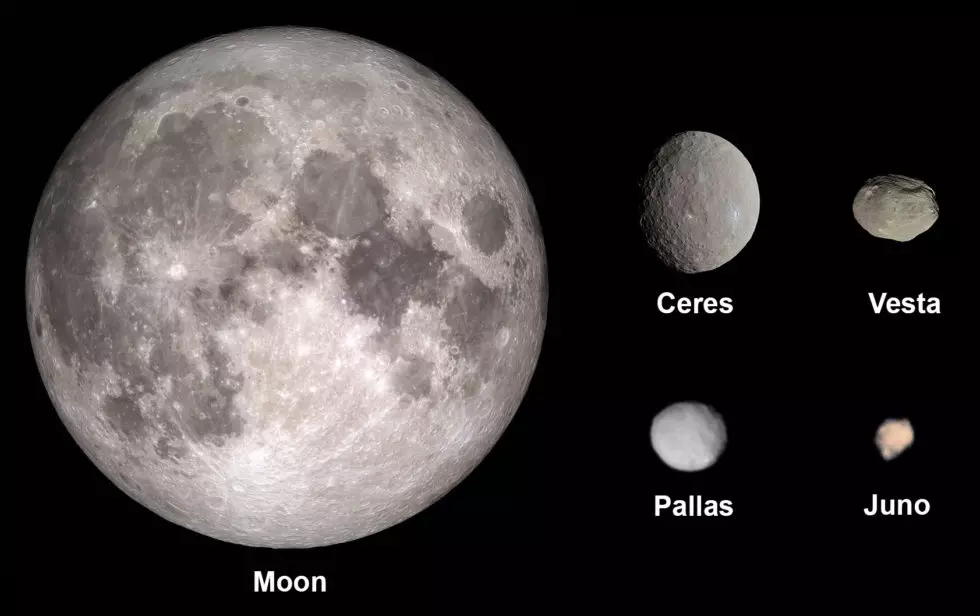 Early speculations that they are the remains of a planet that exploded can now be ruled out because there is insufficient mass. The total mass of all asteroids is less than that of the moon. So, if you could collect all the asteroids into one sphere, it would just be a bigger asteroid, although it would now also be classified as dwarf planet like Ceres. In fact, Ceres constitutes 25% of the mass of all asteroids.
Early speculations that they are the remains of a planet that exploded can now be ruled out because there is insufficient mass. The total mass of all asteroids is less than that of the moon. So, if you could collect all the asteroids into one sphere, it would just be a bigger asteroid, although it would now also be classified as dwarf planet like Ceres. In fact, Ceres constitutes 25% of the mass of all asteroids.
Apparently, asteroids are a unique creation by God. They were created ultimately for his glory, and perhaps for our enjoyment as well.
Properties of the First Four Minor Planets
As you might expect, the first four asteroids are among the largest in our solar system, and consequently among the brightest and most easily detected. All four orbit in between the orbits of Mars and Jupiter, which is where most asteroids are found. At the time of discovery this was thought to be very significant.
Overhead depictions of our solar system reveal a pattern in the spacing of the planets, with the space between their orbits increasing with distance from the sun. But there is a noticeable gap between Mars and Jupiter, as if a planet is missing. And this is exactly where most asteroids are found.¹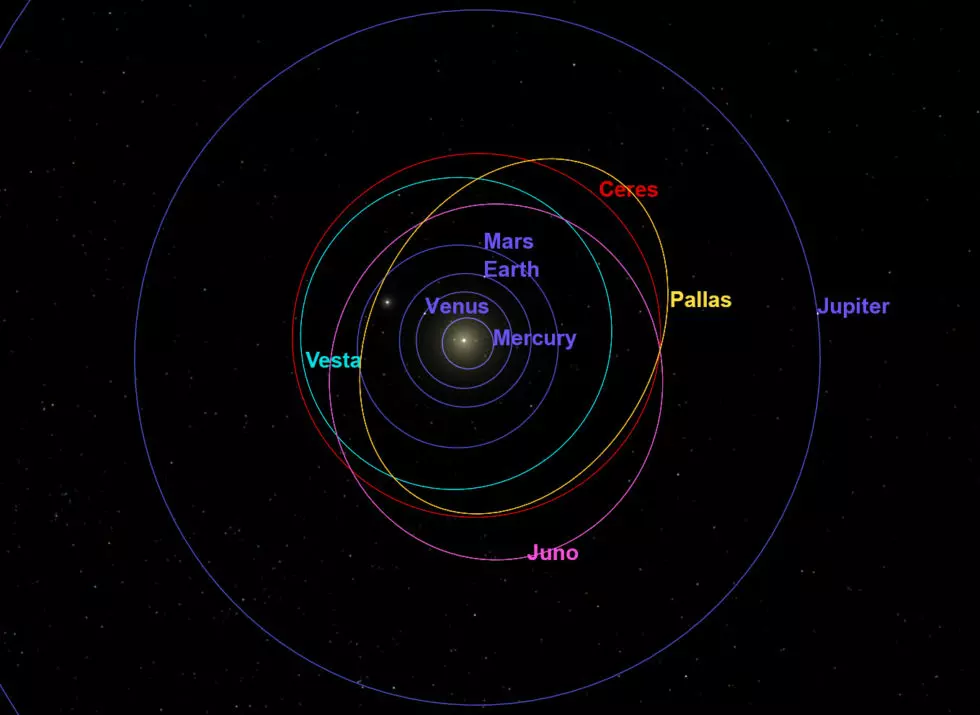
Orbits of the first four asteroids
Ceres is the largest asteroid in our solar system with a diameter of 584 miles. It is the only asteroid large enough to be round under the force of its own gravity. For this reason, Ceres is also classified as a “dwarf planet” and is the only asteroid to have this distinction. So, it has dual citizenship.
Ceres orbits the sun at an average distance of 2.769 AU (257 million miles) with a fairly low eccentricity of 0.076.
Its orbit is inclined by 10.6 degrees relative to the ecliptic; so, it is not quite in the same plane as the planets. This is typical; asteroids tend to have higher inclinations than planets. Ceres rotates once every 9 hours, which is fairly typical for an asteroid.
Today we have beautiful images of Ceres [such as the one at the top of this article], thanks to the Dawn spacecraft which orbited the dwarf planet in 2015. Like all other asteroids, Ceres is essentially a giant rock/ice boulder in space, with insufficient gravity to hold any substantial atmosphere. Interestingly, astronomers have discovered evidence of water vapor emissions from the surface. This may suggest internal heat.
Ceres is too faint to be seen with the unaided eye, but is easily detected with binoculars when closest to Earth. A star chart will be needed since (like all asteroids) Ceres is visually indistinguishable from the background stars.
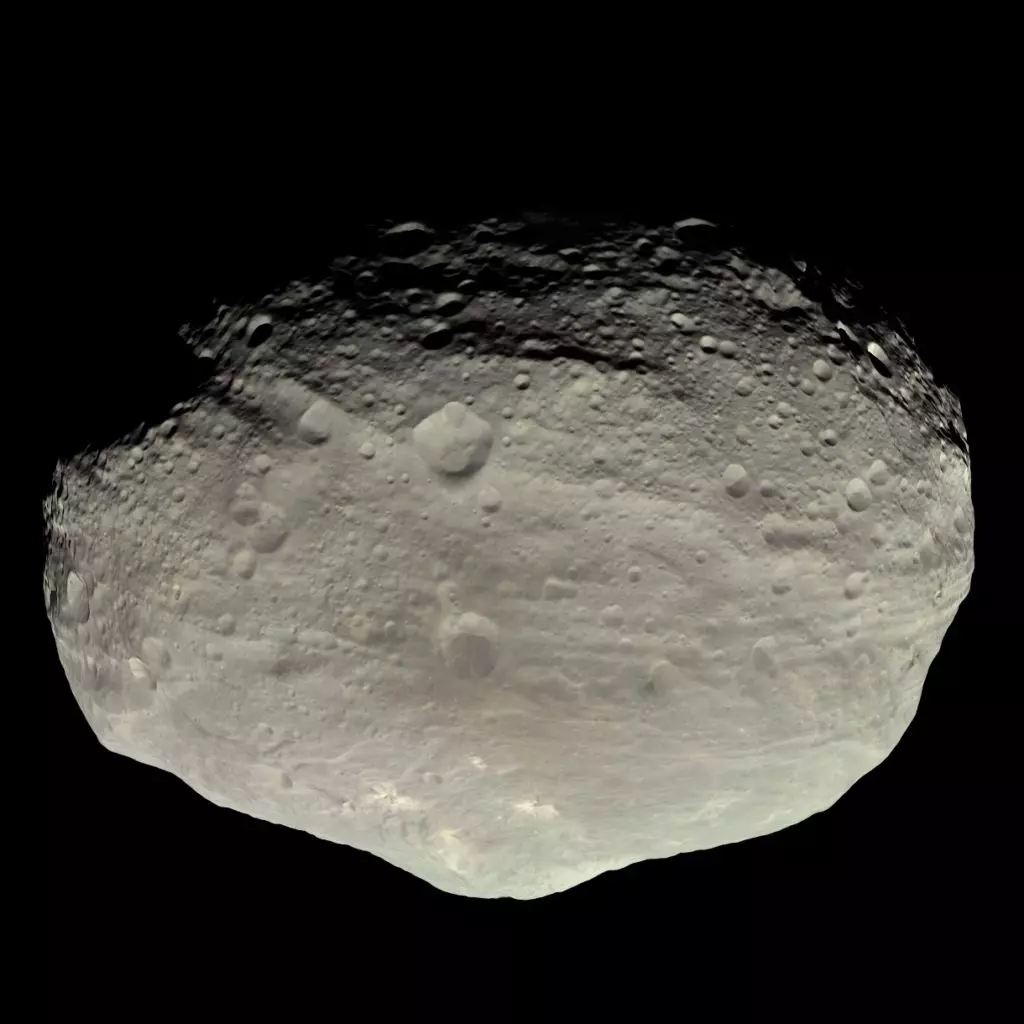
Vesta is the second largest asteroid with an average diameter of 326 miles.² It is also the second most massive, weighing in at about 28% the mass of Ceres. Vesta orbits the sun at an average distance of 2.36 AU (220 million miles) with a period of 3.63 years. It has relatively low orbital inclination (for an asteroid) of 7 degrees and a rotation period of 5.34 hours.
Vesta is the brightest asteroid as seen from Earth. Although smaller than Ceres, it orbits closer to the sun and also comes closer to Earth than Ceres. At its closest approach, Vesta can be seen with the unaided eye under dark skies.
We have spectacular images of Vesta thanks (again) to the Dawn spacecraft which orbited Vesta in 2011-2012. Vesta has an ellipsoidal shape. It has a curious series of “grooves” or troughs along its equator. The largest of these troughs is over 10 miles wide in places and extends over 280 miles, comparable to Earth’s Grand Canyon.
Pallas is the third largest, and third most massive asteroid. It is approximately 320 miles in diameter. Pallas has a much higher orbital inclination than Ceres or Vesta at 34.8 degrees. Its orbit is also far more eccentric (0.23) than the fairly circular orbits of Ceres and Vesta. Pallas rotates on its axis every 7.8 hours. It also has a high axial tilt of 84 degrees, and therefore rotates on its “side” like Uranus. Since no spacecraft has yet visited Pallas, we do not have detailed images.
Juno is currently estimated to be the eleventh largest asteroid. It orbits the sun at an average distance of 2.67 AU (248 million miles), with a period of 4.36 years. It has a fairly typical inclination of 13 degrees, but has a high eccentricity of 0.255. Juno’s rotation period is typical at 7.21 hours, and its axis is tilted 50 degrees. No spacecraft has yet visited Juno, and so we have only ground-based images.
Compositional Taxonomy
As additional asteroids were discovered, it became obvious that they fell into certain categories. Since God is a God of order, many things in our universe can be classified into an organized hierarchy. There is often more than one way to do this. Asteroids are generally classified based on either their composition, or their orbital characteristics.
Based on composition, most asteroids are classified into one of three types: C, S, and M. There are further subdivisions within these categories, and there are some rare types outside these three. The C-type asteroids are the most common, constituting 75% of known asteroids. They are dark gray in color and consist of stony silicate rock with a large amount of carbon. Ceres is a C-type asteroid. Pallas is a B-type asteroid, which is sometimes considered a subcategory of the C-group.
Next most common are the S-types, which are comprised of stony silicate materials. They are generally bright in color. Juno is an S-type asteroid—one of the largest of this category. The M-types are comprised mainly of nickel-iron, and tend to be reddish in color. Vesta is a rare V-type asteroid, and is made of basalt.
The surface composition of an asteroid is estimated based on the observed color, and in many cases, by spectroscopy.³ However, many former asteroids are available for direct inspection because they have impacted the surface of Earth—meteorites. Although M-type asteroids are the least common of the main three types, they are among the most commonly collected meteorites because their high iron easily distinguishes them from Earth rocks.
Footnotes
- The distances of the planets from the sun are approximated by a mathematical rule, sometimes called the Titius-Bode law. It gives the distances of the planets as a=(4+x)/10 where x=0,3,6,12,24,48…. These distances are given in AUs, where 1 AU is defined to be Earth’s distance from the sun. This law works well for all the planets known in 1800, except for the anomalous gap between Mars and Jupiter.
When the first asteroids were found in this gap, it seemed to confirm the Titius-Bode law, which perhaps bolstered their initial classification as planets. The discovery of Neptune challenged such thinking, since it does not follow the Titius-Bode law. Today, the “law” is viewed as an interesting coincidence with no theoretical justification. - In some literature, you may find Pallas listed as the second largest asteroid. However, the latest estimates show that Vesta is very slightly larger than Pallas.
- Spectroscopy is the breaking of light into its constituent wavelengths. The relative strengths of the various wavelengths reveal the composition of the source.

